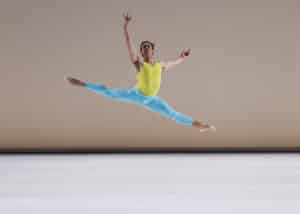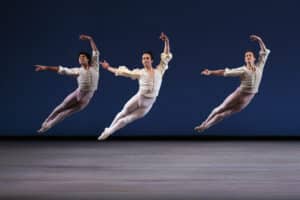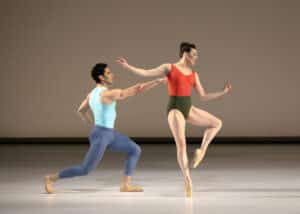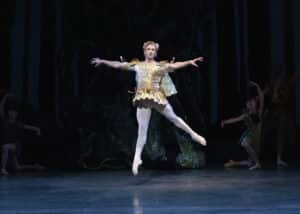
Brillante: Fort Worth’s Roman Mejia lands in the light, reaches big milestone at the New York City Ballet
By Charlotte Settle
Photography by Erin Baiano
Thousands of young dancers dream of landing a spot in New York City Ballet — one of the world’s foremost dance companies. Roman Mejia, who grew up in Fort Worth, achieved that coveted milestone at a mere 17.
Mejia began dancing at 3 at “The Met” — the Metropolitan Classical Ballet — in Arlington, where his father, Paul Mejia, was co-artistic director. From the time he was in diapers, he sat through hourslong Romantic ballets, awestruck.
“He was enamored by it,” his mother, Maria Terezia Balogh, says. “He was making costumes and scenery in his playroom.”

Earlier this year, Mejia, now 23, was preparing for his final performance of NYCB’s winter season. As he warmed up backstage, a company ballet master asked him to stick around after the show to discuss a promotional photo shoot. “I thought it was a little strange,” says Mejia, who is normally notified of photo ops by email. Nevertheless, he agreed to the meeting.
Mejia was surprised to find the company’s artistic director, Jonathan Stafford, waiting for him backstage after the show. He quickly realized the photo shoot had been a ruse, and moments later, Stafford promoted him to the highest possible position in a ballet company — principal dancer. “I wasn’t expecting it,” Mejia says. “I was so happy. It was a dream come true.”
Known for his boundless energy, flawless technique and charismatic charm, Mejia has steadily climbed the ranks of NYCB over the last six years — and he’s just getting started. He has become a household name in the ballet world and an idol to aspiring young dancers. “It’s astounding,” Balogh says. “He’s wonderful out there. He just goes for broke.”
His talent for ballet was written in Mejia’s genes. His father was a soloist with NYCB under George Balanchine, the company’s founding artistic director and one of the most influential choreographers of the 20th century. Balogh was a principal dancer with Chicago City Ballet and Fort Worth Dallas Ballet, both of which his father directed in the ’80s and ’90s.

Roman Mejia of NYCB in Justin Peck’s Copland Dance Episodes.
Growing up, Mejia was largely unaware of his family’s legacy. “I knew that my parents had something to do with ballet,” he says. “But I didn’t really know quite the extent of it.” Mejia’s parents encouraged him to carve his own path. If he chose dance, it would be on his own terms. “My parents never forced anything upon me,” Mejia says. “They gave me my own freedom.”
Mejia attended middle school at the Fort Worth Academy of Fine Arts, where he zeroed in on ballet. He enrolled in classes outside of school at Ballet Academy of Texas — a large studio in Coppell, where, for the first time, he had male classmates with whom he could compete. There, he learned about the prestigious School of American Ballet, the official training affiliate of NYCB.
When Mejia expressed interest in SAB at 13, his parents were surprised — but delighted. “We were thrilled, because we knew he was capable,” Balogh says. Still, there was work to do.
For the majority of his life, Mejia had trained with his father’s coartistic directors at The Met — former professional dancers with the esteemed Bolshoi Ballet in Russia.

Roman Mejia and Tiler Peck of New York City Ballet in George Balanchine’s Allegro Brillante
His Russian classical training, while prestigious, was centered around dramatic story ballets like Swan Lake and Giselle. Balanchine’s neoclassical choreography, which makes up the majority of NYCB’s repertoire, embodies a style, athleticism, and musicality that requires its own technique. Mejia’s parents, having built their careers on Balanchine’s ballets, decided to open their own studio to train him in the distinct style.
It didn’t take long for Mejia to get up to speed on the Balanchine technique. “He astounded us every day with how hungry he was,” Balogh says.
At age 14, after his first year of training with his parents, Mejia was selected from thousands of dancers who auditioned internationally to attend the SAB summer program. The following year, he accepted an offer to attend the school’s exclusive year-round training program — typically reserved for students who have a shot at joining the company.

Roman Mejia and Tiler Peck of NYCB in Justin Peck’s Copland Dance Episodes
“I moved away before I learned how to drive,” Mejia says. While most 15-year-olds living on their own in New York might succumb to culture shock, Mejia thrived in the city. “I really enjoyed the energy,” he says.
He spent two consecutive years at SAB, training exhaustively while taking high school courses online. He stood out among his classmates, landing lead roles in the school’s end-of-year shows. During his second year, he was invited to perform with NYCB.
For his first-ever role with the company, Mejia played a mouse in The Nutcracker. “I remember being in this huge suit backstage, and right before my entrance, I almost teared up,” Mejia says. “I was thinking, ‘This is literally my dream. I can’t believe I made it.’” Little did Mejia know, a career-altering break was right around the corner.
The following summer, Mejia was invited to perform at Vail Dance Festival — a critically acclaimed performance series in Colorado featuring internationally renowned dance stars. The festival’s artistic director, Damian Woetzel, had been looking for fresh talent. He asked NYCB’s premier prima ballerina, Tiler Peck, which up-and-comer he should invite from the company. Of the roughly 90 dancers she could have chosen, Peck picked Mejia, who at the time was still a student at SAB. Mejia, who had idolized Woetzel as a young dancer, couldn’t believe it. “I was over-the-roof excited,” he says.
At the festival that year, Mejia, then 17, debuted in his first ever lead role, in Balanchine’s remarkably challenging Tarantella. From then on, there was no questioning what he was capable of. NYCB offered him a spot in the corps de ballet (ensemble) that fall, and he immediately landed his first featured role with the company — Mercutio in Romeo + Juliet. Shortly thereafter, Peck chose Mejia to be her partner in Balanchine’s exuberant Allegro Brillante — one of his favorite performances to date.
Throughout Mejia’s time in the corps de ballet, he was repeatedly cast in featured roles. He remained Peck’s preferred partner over dozens of tenured dancers in the company. His promotion to soloist in 2021 signified little other than a rite of passage — and a farewell to occasionally performing in the ensemble.
Given Mejia’s reputation, his promotion to principal is arguably long overdue — and undoubtedly would have happened sooner if it hadn’t been for a hiatus during the pandemic.
Now that he has reached the pinnacle of NYCB, Mejia looks forward to adding more pas de deux to his repertoire of mostly high-energy solo work. “I love partnering,” says Mejia. “I find a lot of joy in it.”

Roman Mejia and Tiler Peck of New York City Ballet in George Balanchine’s Allegro Brillante
Mejia dreams of dancing Balanchine’s Prodigal Son and Apollo. “For a male dancer at New York City Ballet, those are the most iconic roles,” he explains. They are also two of the first Balanchine ballets he ever saw — both staged by his father, back home at The Met.
Though Mejia is living his dream, he is the first to admit his lifestyle is far from glamorous. In a typical NYCB season, he will perform seven to eight unimaginably demanding shows per week.
“A lot of the time you’re tired, and you have to rehearse new ballets on top of the shows,” Mejia says. “You won’t necessarily have fresh legs for the performance that evening, as much as you wish.”
Most mornings, Mejia walks from his apartment near Lincoln Center to NYCB. His day starts with an hourlong company warmup class at 10:30 a.m. He rehearses ballets between 11:30 a.m. and 6:00 p.m., and if the company is in the middle of a season, he will perform in the evening.
On the rare occasion he’s not called for rehearsal or finishes his day early, Mejia often hits the gym to keep his body moving. This is the norm for him Tuesday through Sunday; the company has Mondays off.
During his little downtime, Mejia has only one objective: relax. “I’m notorious for kind of overworking myself,” he says. “Taking the day off is really important.”
Physical therapy and massage are part of his daily maintenance, and when he’s resting at home, he’s likely watching Netflix or playing video games. When Mejia feels like getting out, he loves venturing to new restaurants in his neighborhood.
Mejia recently wrapped up a run of shows with NYCB at The Kennedy Center in Washington, D.C. Though the company is on a monthlong break, he has no intention of slowing down. He and Peck will head to Mexico City to perform William Forsythe’s The Barre Project, a piece the renowned choreographer created for the pair over Zoom during the pandemic.
“I think it’s good to have a week off, but it’s important to keep your body active,” Mejia says. “The schedule is so rigorous that you could break something if you don’t keep moving.”
Though he is content with where he is, Mejia is keeping an open mind for his future. “I want to explore other things, see the world and dance with different companies,” he says.
Though NYCB will always be his home, Mejia dreams of one day dancing what the company’s repertoire lacks — the sweeping Russian story ballets on which he was raised.
For Mejia, a future of ballet superstardom surely awaits. But of all his astonishing accomplishments, his humility and kindness stand out the most.
His character — more than his thriving career — makes his parents the most proud. “He’s a really good person, and isn’t that the bottom line?” Balogh asks. “Nothing is more important than when your child is excelling, happy, healthy — and kind.”
